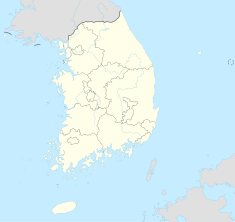Yungneung
| Yungneung and Geolleung | |
|---|---|

Geolleung
|
|
| Location | Hwaseong, Gyeonggi-do, South Korea |
| Coordinates | 37°12′44″N 126°59′26″E / 37.21222°N 126.99056°ECoordinates: 37°12′44″N 126°59′26″E / 37.21222°N 126.99056°E |
| Built | 1816; 1821 |
| Governing body | Cultural Heritage Administration of Korea |
| Type | Cultural |
| Criteria | iii, iv, vi |
| Designated | 2009 (33rd session) |
| Reference no. | 1319 |
| State Party |
|
| Region | Asia and Australasia |
|
Yungneung and Geolleung in Hwaseong
|
|
| Yunggeolleung | |
| Hangul | 융건릉 |
|---|---|
| Hanja | |
| Revised Romanization | Yunggeolleung |
| McCune–Reischauer | Yunggŏllŭng |
Yungneung and Geolleung are two royal tombs from the Joseon Dynasty within an oak-forested park in Hwaseong, South Korea. Yungneung is the tomb of Crown Prince Sado and Princess Hyegyeong, while Geolleung houses King Jeongjo and Queen Hyoui. The tombs are part of the UNESCO-listed World Heritage Site of the Royal Tombs of the Joseon Dynasty.
37°12′42″N 126°59′38″E / 37.21167°N 126.99389°E
Crown Prince Sado (1735-1762), having been killed by his father King Yeongjo, was buried on Mr Baebongsan in Yangju. In 1789, his body was moved to its current location, then called Hyeollyungwon, by his son King Jeongjo. In 1816, Prince Sado's wife, Princess Hyegyeong, was buried with her husband. In 1899, when Prince Sado and Princess Hyegyeong were posthumously elevated in status and given the titles Emperor Yangjo and Empress Heonyeong, the tomb was also upgraded and renamed Yungneung.
The tomb itself features retaining stones around its perimeter and is decorated by capstones featuring prominent carved lotuses, possibly to soothe the spirit of Prince Sado, whom his son believed was killed before reaching his full potential. The tomb is guarded by statues on the downward slope, at the bottom of which sits a shrine, which is in turn led to by a wide worship road. There are two other buildings in the immediate vicinity: a royal kitchen and a shelter for two memorial steles. The memorial road is accessed via a red spiked wooden gateway, which stands a short distance from a circular pond. This, symbolising the wish-granting bead of a dragon, and therefore King Jeongjo's love of his father, is an unusual feature for a royal tomb from the Joseon era.
...
Wikipedia

